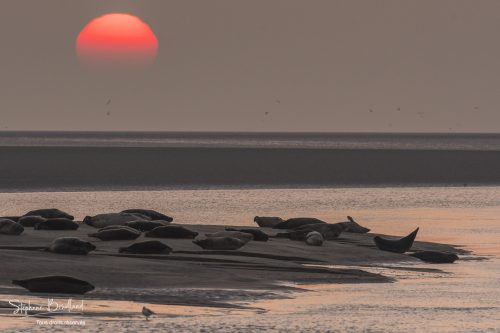Photographing seals in Baie de Somme
Their presence has been widely mediatized and the seals present in the Bay of the Somme and the Bay of Authie are today the real stars of the Picardy coast. Their friendly character has naturally raised them to the rank of mascot. Apart from a few grumpy people, the local population has completely adopted them, and every tourist wants to see his seal before leaving, thus developing a tourist economy. Many photographers also want to capture some of their mimics...
A historical presence
Historically very present in the Bay of the Somme, seals disappeared at the beginning of the 20th century, their population decimated by hunting. The protection measures put in place in 1972 nevertheless allowed the Bay of the Somme colony to gradually rebuild and to swarm northward along the Opal Coast, notably in the Bay of Authie.
Today there is an average of 160 sedentary seals in the Bay of the Somme, but the numbers can more than double in summer with individuals from England and the Netherlands. Similarly in the Bay of Authie, there are about 30 to 80 individuals. Approximately 40 births are observed each summer in the common seals that make up the majority of the population, while grey seals do not generally reproduce in the Bay of the Somme. Indeed, the common seal and the grey seal are the two species that coexist in the Bay of the Somme and the Bay of Authie, and differentiating between them requires some practice even if the shape of the head is essentially different.
When to watch seals?
The life of seals in the Baie de Somme is essentially regulated by the tides. At high tide, they disperse and follow marine currents to feed, either on the bottom of the Bay or in the Channel where they can move 60 km away from the coast between tides. When the tide goes out, the sandbanks emerge little by little and it is the signal for the seals to gather and reach their resting places, they become gregarious again.
These resting places are carefully chosen, with a sufficiently steep slope and always close to a deep channel, so that the animals can quickly flee in case of danger or disturbance. If it is at ease in the water, the seal is indeed quite clumsy on land or it only moves by crawling; it is therefore much more fearful on sandbanks than in the water and takes care to systematically provide itself with an escape route.
The colony thus reformed at each low tide, usually in several groups. During the whole period of low tide, the seals will remain more or less motionless, although they regularly change position, rolling from one side to the other, adopting the position known as "the banana", sleeping on their stomach or on their back... For the photographer, this is the opportunity to capture attitudes that are sometimes quite comical. The somewhat extreme climatic conditions are interesting: seals in the sand wind or any smoke from condensation in very cold weather offer unusual images.
Where to see the seals?
In the Baie de Somme, seals can be found almost everywhere. It is however in the Hourdel that they are most easily observable. At low tide, they settle on the sandbanks along the Somme channel. The place is favourable for group photos, the colony can be numerous in summer, a long focal length (500 mm) is generally necessary. The use of drones is possible as long as one does not enter the nature reserve and by keeping a sufficient altitude so as not to frighten the animals.
For photo, the site of Berck-sur-mer is probably the one that offers the best proximity with the animals. The deep channel of the Authie is a security for them and the tolerance distance is reduced to 10 to 20 meters, sometimes less. To photograph them out of the water, it is undoubtedly the place that offers the most possibilities without disturbing the animals, with a beautiful lighting in the morning and evening. In the morning the animals are bathed in a beautiful golden light, while in the evening it is possible to treat the subject as a landscape thanks to the sunset in the background...
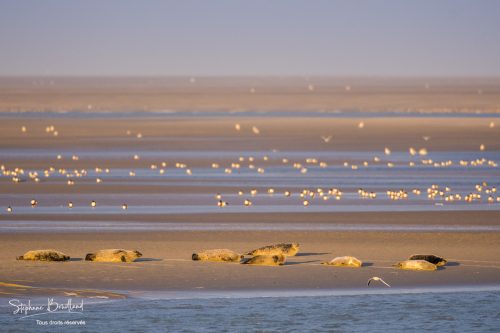
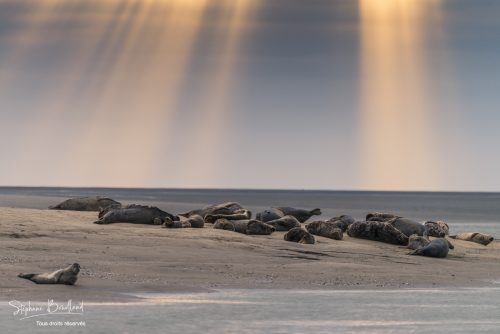
When do seals move?
Once installed on the sandbank, the seals move little and the photographer gets bored quickly. The images of the seals sleeping on the sand being easy to achieve, the challenge for the photographer quickly becomes to achieve dynamic images by exploiting the moments when the seals are animated or adopt unstable postures, but also by using the swirl of the water and the splashes that give movement to the images. It is therefore better to focus on the moments when they arrive or leave. Personally, I prefer the moment when the rising tide dislodges them (2 to 3 hours before the high tide), the launches are then facing the photographer. We see them getting restless, moving around to stay dry longer, adopting the famous "banana" attitude...
Mainly in autumn, it is often at this time that we see game scenes and simulated confrontations between grey seals that are quite interesting to catch. The animals then stand up against each other, sand and water gush out and a few hoarse cries are heard... it's quite an atmosphere!
Finally, at high tide, the seals start fishing in the channel and their natural curiosity pushes them to get close to humans, offering multiple opportunities to get close to them!
What equipment to photograph seals?
In terms of equipment, long focal lengths (500mm and multiplier, 200-500mm, 150-600mm) are almost indispensable for photographing full frame seals. However, it is not necessary to use a high frame rate camera because these animals move slowly. Finally, for those who would be interested to try the adventure, I advise to dress with protection from the wind, and to bring boots because the seawall is quite slippery and at rising tide the waves invade it very quickly! You should also know that the place is also well frequented by birds, which makes it possible to fill the waiting time. During the migration period, the passages are frequent, but all year long we meet gulls, seagulls, cormorants, egrets, and more occasionally sandpipers, terns, gravel plovers... My last piece of advice will be to avoid the school vacations during the day because the place is narrow and very busy, putting a tripod there quickly becomes complicated and risky.
The seal colony in Baie de Somme
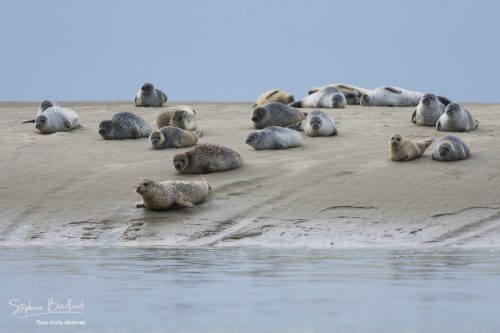
We generally refer to the writings of a senator of the Somme at the end of the 19th century as proof of the presence of seals in the Baie de Somme at that time. The author describes a population of several hundred seal calves, which were hunted for their skin, blubber and meat. At the beginning of the 20th century, hunting pressure became so strong that the species quickly disappeared. Thus, from 1930 to 1970, seeing a seal in the Bay of the Somme was exceptional.
However, it was not until 1972 that measures to protect the species were put in place:
- 1972: Hunting ban in France (1962 in the Netherlands);
- 1979 : Species listed in Appendix III (protected fauna species) of the Bern Convention on the Conservation of European Wildlife and Natural Habitats ;
- 1979: Species listed in Appendix II of the Bonn Convention on the Conservation of Migratory Species of Wild Animals ;
- 1992 : Species listed in Annex II of the European Union Directive "Habitat-Fauna-Flora";
- 1995: Species protected under the decree relating to the list of marine mammals protected on the national territory;
The results of these protective measures began to be seen in 1986 with a small group of 10 to 15 calf seals returning to the Baie de Somme. The arrival of these first "settlers" was due in part to a characteristic of the species: juvenile erraticity. Thus, after weaning, the young can spread over long distances, sometimes up to more than 300 kilometers. These pioneers were gradually joined by others from England and the Netherlands, and it was in 1988 that the first birth was observed, the population being considered as a breeding population (1 young per year) only since 1992.
Counts carried out by the Picardy-Nature association, which conducts the program to study and protect seals in the Baie de Somme, show a constant increase in the population. Over the 1986-2011 period, the average rate of population growth was 17% and in August 2012, 370 common seals and 92 grey seals were counted in the Baie de Somme. These are the maximum numbers, which do not represent the sedentary population estimated on average at 160 common seals and 35 grey seals. Indeed, the numbers are highly variable, especially in the summer when individuals from other sites are added to the sedentary animals to form a larger colony, in which sexually mature individuals can reproduce. In recent years, at least 40 births have been observed each summer in common seals in the Baie de Somme.
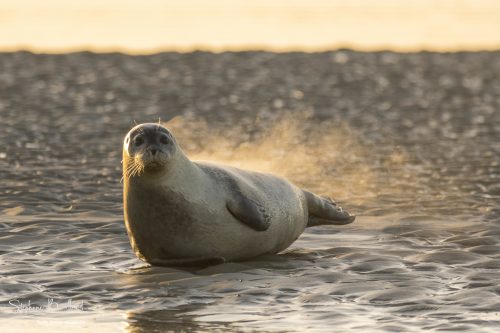
It is a great success but it remains modest compared to the colonies of thousands of individuals from the coasts of Wash in the south-east of England, or those of the Wadden Sea (Netherlands / Denmark) where they seem to come from... Nevertheless, the colony of the Bay of the Somme represents nearly 60% of the French population of common seals.
Grey seals are less numerous and the species is not considered sedentary or reproductive, although it is present year-round and several births have been observed. Indeed, these births have generally ended in failure because the fur of the young "whitecoats" absorbs water and does not allow them to swim the first three weeks of their lives. While waiting for its first moult, it must stay dry on sandbanks not covered by the tide, otherwise it will drown. There is no such place in the Baie de Somme, at least not enough frequented by men to guarantee the necessary tranquility. Grey seals are therefore mainly observable outside their calving period, where they mix with common seals and share the same resting places.
Seals also find in the bay, the sandbanks that they particularly like and which are formed thanks to the effect of the tides in the estuary. It is therefore quite naturally that the species has also colonized the Bay of Authie, whose environment presents a strong similarity with that of the Bay of the Somme, and this since the 2000s. Also in August 2012, 48 common seals and 17 grey seals (33 in October) were counted in the Bay of Authie and are now regularly seen further north.
Grey seal and common seal : how to differentiate them?
The characteristics allowing to recognize them are mainly located at the level of the head, the only visible part in the sea:
- The common seal has a round head, a short snout, a well-marked indentation between the forehead and the muzzle, V-shaped nostrils and the ear hole is clearly visible.
- The grey seal has an elongated snout in the extension of the forehead, and parallel nostrils.
When the animal is on the sand, we can see a more pronounced neck in the grey seal, with a more mobile head. On the other hand, but this is not an absolute rule, the fur of the common seal is strewn with fine lighter markings, unlike that of the grey seal, which has large lighter spots. The coloring is variable: light to dark gray, beige, brown, with often a lighter part on the belly in the common seal. Finally, in adults, grey seals are generally larger in size than common seals. The male grey seal can reach 3m in length for 250 kg while the common seal rarely exceeds 2m and 120 kg in the region.
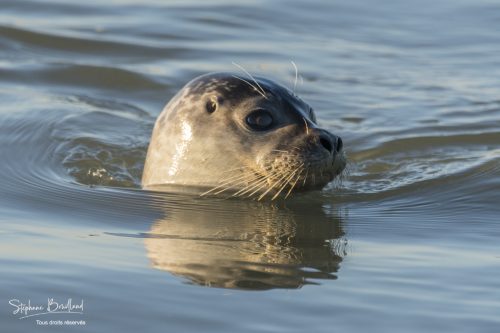
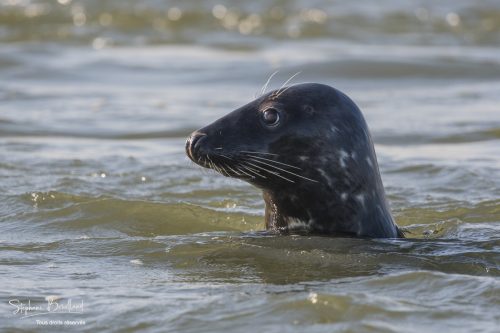
Photographing seals: beware of disturbances!
The long stations on the sandbanks are essential to the physiology of the seals, that is why it is imperative to respect their tranquility. It is indeed during these periods that the seal stores a thick layer of subcutaneous fat which allows it to ensure its thermoregulation and to store energy for its locomotion. Likewise, every summer, the seal moults and sheds its fur (June to September), and it is the solar energy stored during rest periods that allows it to synthesize the vitamin D necessary for the regrowth of its new fur.
Finally, these periods are also used for reproduction, giving birth and breastfeeding babies. Repeated disturbances disrupt its life cycle and endanger newborns. Attempts to approach them systematically lead to their escape to the water, at the risk of separating the mother and her baby. A quarter of births are thus compromised each year, especially because they occur in June and July, when tourists are the most numerous!
Riders, kayaks, pleasure boats, walkers or photographers unfortunately regularly provoke untimely launches that are harmful to animals, often due to ignorance. It is therefore advisable to constantly inform as many people as possible about the rules to be respected, so that this small, very friendly colony continues to prosper! A distance of at least 100 m is to be respected, and if the seals raise their heads or start to get closer to the edge of the channel it is because you are too close! For your first visit, have a walk with a Qualinat certified nature guide who will tell you where and when to take your pictures without disturbing the species.
